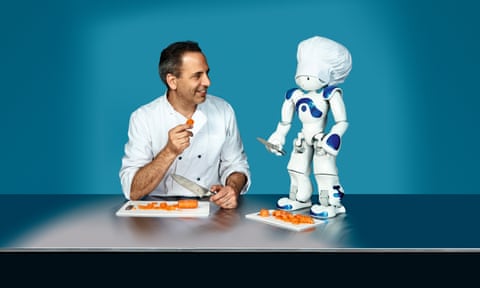One video, for me, changed everything. It’s footage from the old Atari game Breakout, the one where you slide a paddle left and right along the bottom of the screen, trying to destroy bricks by bouncing a ball into them. You may have read about the player of the game: an algorithm developed by DeepMind, the British artificial intelligence company whose AlphaGo programme also beat one of the greatest ever Go players, Lee Sedol, earlier this year.
Perhaps you expect a computer to be good at computer games? Once they know what to do, they certainly do it faster and more consistently than any human. DeepMind’s Breakout player knew nothing, however. It was not programmed with instructions on how the game works; it wasn’t even told how to use the controls. All it had was the image on the screen and the command to try to get as many points as possible.
Watch the video. At first, the paddle lets the ball drop into oblivion, knowing no better. Eventually, just mucking about, it knocks the ball back, destroys a brick and gets a point, so it recognises this and does it more often. After two hours’ practice, or about 300 games, it has become seriously good, better than you or I will ever be. Then, after about 600 games, things get spooky. The algorithm starts aiming at the same spot, over and over, in order to burrow through the bricks into the space behind. Once there, as any Breakout player knows, the ball will bounce around for a while, gathering free points. It’s a good strategy that the computer came up with on its own.
“When our researchers saw this, that actually shocked them,” DeepMind’s CEO, Demis Hassabis, told an audience at a technology conference in Paris. You can watch his demonstration, too, and hear the laughter and applause when the machine figures out its burrowing strategy. The computer has become intelligent, a bit like us.
“Artificial intelligence” is just about the oldest and most hyped of all computing’s buzz phrases. The idea was first mooted seriously by Alan Turing in Computing Machinery And Intelligence, the 1950 paper in which he proposed what became known as the Turing test: if a machine could convince you through conversation that it was human, it was doing as much as any human could to prove it was truly thinking. But the term AI was not generally used until 1955, when American mathematician John McCarthy proposed a conference for experts. This took place the following year, and since then the field has run on a roughly two-decade cycle of mania and despair. (Researchers even have a new term – “AI winter” – to describe its spells out of fashion. The 1970s and 1990s were particularly harsh.)
Today there’s a new mania, which looks different from the others: it fits in your pocket. A phone can beat the world chess champion, recognise songs on the radio and pictures of your children, and translate your voice into another language. The Nao robot pictured here with Yotam Ottolenghi can walk on two legs, speak, find a ball and even dance. (It’s a robot, though, not AI: it can’t design a menu.)
Hearing about the advances in AI, you don’t need an expert to tell you to be excited, or scared. You just start to get the feeling: intelligence is here. Clearly Google got the feeling, too, because it bought DeepMind for a rumoured $650m. In 2013, Facebook launched its own project, with plans to develop facial and natural language recognition for the site. Developers have already begun work on intelligent chatbots, which Facebook users will be able to summon using its Messenger service.
So far, computers haven’t been “intelligent” at all, or only narrowly so. They’ve been good at easy tasks that dazzle us, such as maths, but bad at those we take for granted, which turn out to be seriously hard. The act of walking is something modern robots learn like babies and still struggle with; basic pottering tasks remain distant dreams. “One example is the ease with which you or I could make a cup of tea in someone else’s kitchen,” says Professor Alan Winfield, a roboticist at the University of the West of England. “There isn’t a robot on the planet that could do this.”
To understand why being human is so difficult, think about how you might get a computer to recognise people from photographs. Without AI, you have to know how you do it yourself first, in order to program the computer. You have to collect and think about all the possible patterns, colours and shapes of faces, and how they change in the light and at different angles – and you have to know what is significant and what is just mud on the lens. With AI, you don’t have to explain: you just give a mountain of real data to a computer and let it learn. How you design the learning software remains an esoteric matter, the province of a few sought-after computer scientists, but it’s clear they’ve got on to a winner by devising structures of data-processing based loosely on the structures in the brain. (This is called “deep learning”.) As for the mountains of real data, well, that’s what Google, Facebook, Amazon, Uber and all the rest happen to have lying around.
At this stage, we don’t yet know which uses of AI will turn out best. Josh Newlan, a California coder working in Shanghai, got bored with listening to endless conference calls, so he built some software to listen for him. Now, whenever Newlan’s name is mentioned, his computer instantly sends him a transcript of the last half-minute, waits 15 seconds, then plays a recording of him saying, “Sorry, I didn’t realise my microphone was on mute.” Last year, Josh Browder, a British teenager, built a free artificial lawyer that appeals against parking tickets; he plans to build another to guide refugees through foreign legal systems. The possibilities are… Well, maybe an algorithm can count the possibilities.
So will machine minds one day outstrip our own? The researchers I speak to are cautious, and take pains to emphasise what their machines can’t do. But I decided to put AI to the test: can it plan a meal as well as Ottolenghi? Can it paint my portrait? Is technology still artificially intelligent – or is it starting to be intelligent, for real?
The cooking test
Well, I will say it isn’t horrible. Humans have served me worse. Although in truth the name that IBM’s Chef Watson gives this dish (“Chicken Liver Savoury Sauce”) is about as appetising as it deserves.
To be fair to Chef Watson, and to Guardian Weekend’s own chef-columnist Yotam Ottolenghi, I had set them quite a task. I asked for a dish based on four ingredients that seemed to belong nowhere near each other: chicken livers, Greek yoghurt, wasabi and tequila. They could add whatever else they liked, but those four had to be in the finished dish, which I would cook and eat. Chef Watson didn’t hesitate, instantly giving me two pasta sauces. Ottolenghi was more circumspect. “When I got the challenge I thought, ‘This is not going to work,’” he tells me.
I thought the same. Or at least I thought I would end up eating two dishes that managed to be OK despite their ingredients, rather than because of them. In fact – and you’ll think me a creep, but so what – Ottolenghi’s recipe was a revelation: liver and onion and a tequila reduction, served with an apple, radish, beetroot and chicory slaw, with a wasabi and yoghurt dressing. The dish may make little sense on paper, but I devoured a plateful feeling that every element belonged. (And vinaigrette thickened with yoghurt and wasabi instead of mustard: seriously, give it a try.) Ottolenghi tells me the recipe is just a whisker short of publishable.
The thing is, that dish took him and his team three days to perfect. They were able to taste and discuss flavours, textures, colours, temperatures, in a way that Watson can’t – although there have been “discussions” about adding a feedback mechanism in future, Chef Watson’s lead engineer, Florian Pinel, tells me. “A recipe is such a complex thing,” Ottolenghi says. “It’s difficult for me even to understand how a computer would approach it.”
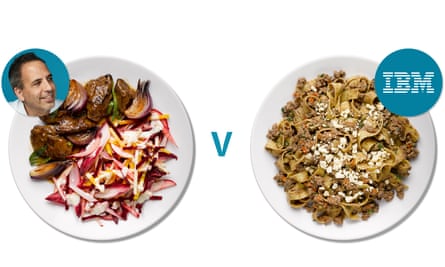
Watson was first built by IBM to win the television gameshow Jeopardy! in 2011. In some ways it was a misleading challenge, because for a computer the tough part of a quiz is understanding the questions, not knowing the answers; for humans, it’s the other way around. But Watson won, and its technology began to be applied elsewhere, including as a chef, generating new recipes based on 10,000 real examples taken from Bon Appétit magazine.
First the software had to “ingest” these recipes, as the Watson team put it. A lot of computation went into understanding what the ingredients were, how they were prepared, how long they were cooked for, in order to be able to explain how to use them in new dishes. (The process can still go awry. Even now Chef Watson recommends an ingredient called “Mollusk”, which it helpfully explains is “the sixth full-length album by Ween”.)
A bigger problem was trying to give the machine a sense of taste. “It’s easy enough for a computer to create a novel combination,” Pinel says, “but how can it evaluate one?” Watson was taught to consider each ingredient as a combination of specific flavour compounds – of which there are thousands – and then to combine ingredients that had compounds in common. (This principle, food pairing, is well established among humans.) Finally, the software generates step-by-step instructions that make sense to a human cook. The emphasis is on surprises rather than practical meal planning. “Chef Watson is really there to inspire you,” Pinel explains. Each recipe comes with the reminder to “use your own creativity and judgment”.
And I need to. The first step is to “toast flat-leaf parsley”, which just isn’t a good idea. I am making, effectively, a slow-cooked spiced pork and beef ragu, including all my four ingredients, yet Watson oddly also includes cucumber and keeps telling me to “season with allspice”, which I refuse to do on principle. In the end, I have a rich sauce with a flavour rather close to the farmyard, but not uneatable. I can’t taste the wasabi or the tequila, which I’m glad about.
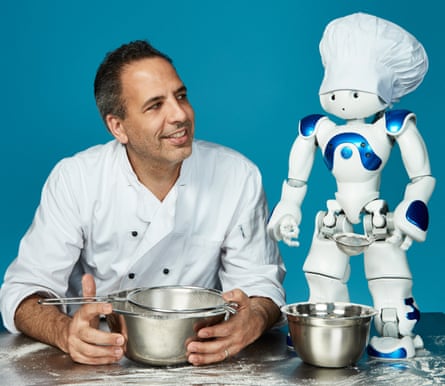
Watson is clever and the task is tough, but I am ready to say that this is no more than a bit of fun for food nerds, until Ottolenghi stops me. “I think the idea of slow-cooking the livers with a bit of meat is great,” he says. “It intensifies the flavour. Everything will come together. If I had to start afresh with this recipe, obviously the yoghurt doesn’t fit – but I would leave the orange skin there, a few of the spices. I don’t think it’s a very bad recipe. It could work.”
Verdict Watson hides the weirdness of the ingredients, but Ottolenghi makes them sing.
The writing test
Put little Wordsmith next to the fearsome machines of IBM and Google, and it looks as computationally advanced as a pocket calculator. Yet while Watson fumbles through its apprenticeship, Wordsmith is already at work. If you read stock market reports from the Associated Press, or Yahoo’s sports journalism, there is a good chance you’ll think they were written by a person.
Wordsmith is an artificial writer. Developed by a company in North Carolina called Automated Insights, it plucks the most interesting nuggets from a dataset and uses them to structure an article (or email, or product listing). When it comes across really big news, it uses more emotive language. It varies diction and syntax to make its work more readable. Even a clumsy robot chef can have its uses, but writing for human readers must be smooth. Hooked up to a voice-recognition device such as Amazon’s Echo, Wordsmith can even respond to a spoken human question – about the performance of one’s investments, say – with a thoughtfully spoken answer, announcing what’s interesting first, and leaving out what isn’t interesting at all. If you didn’t know the trick, you’d think Hal 9000 had arrived.
The trick is this: Wordsmith does the part of writing that people don’t realise is easy. Locky Stewart from Automated Insights gives me a tutorial. You write into Wordsmith a sentence such as, “New ABC figures show that the New York Inquirer’s circulation rose 3% in April.” Then you play around. The 3% has come from your data, so you select the word “rose” and write a rule, known as a “branch”, which will change the word “rose” to the phrase “shot up” if the percentage is more than 5%. Then you branch “rose” to become “fell” if the percentage is negative. If the percentage is -5% or lower, “rose” becomes “plummeted”.
Then you feed it synonyms. So “plummeted” can also be “fell sharply by”. “The Inquirer’s circulation” can be “circulation at the Inquirer”. “Shot up” can be “soared” and so on. Then you add more sentences, perhaps about online traffic, or about which days’ print copies sold best, or about comparisons year-on-year. Then you get clever. You tell Wordsmith to put the sentences with the most newsworthy information first, defined perhaps as those that feature the greatest percentage changes. Maybe you add a branch to say that a result is “the best/worst performance among the quality titles”. Hell, you can even teach it some old Fleet Street tricks, so that if circulation plummets the piece begins “Editor Charles Kane is facing fierce criticism as”, but if circulation has “shot up” this becomes “Charles Kane has silenced critics with news that”. Insert “more” or “again” or “continues” if you get the same thing two months in a row.
“The artificial intelligence is actually the human intelligence that is building the network of logic,” Stewart says, “the same network you would use when writing a story. It could have been developed 10 or 15 years ago, in code, but to make it work at this scale has only been possible lately.” Clearly it takes longer to prepare an article on Wordsmith than to write one conventionally, but once you’ve done so, the computer can publish a fresh newspaper circulation story every month, on every newspaper, within seconds of receiving the information. It can publish millions of stories in minutes – or publish only some of them, if the data doesn’t reach a given threshold of newsworthiness. Thus it becomes an automated editor, too, with adjustable tastes in thoroughness, frequency and hysteria.
For Wordsmith’s task, I suggest football: it’s a field that produces a lot of data and has a readership that wants personalised articles. Guardian football writer Jacob Steinberg volunteers to take on the computer, and I provide a table of facts from the recent Premier League: last season’s league position and this season’s position at Christmas and at the end, goals scored and conceded, top scorer’s name and total, value of summer transfers and a quote from the manager.
Working solely from this data, computer and human must each write a review of the season for a given club. Steinberg chooses Leicester City on the basis that its numbers should contain a story that anyone would see. Wordsmith doesn’t need to choose. It will do all 20.
And in fact both computer and human quickly produce quite similar work:

Both Steinberg and Wordsmith deliver dramatic first sentences. Perhaps keen to sound authentic, Automated Insights use some clever tricks to put feeling into the latter’s article, astutely guessing that Leicester were “hoping to finish in the top 10 after a 14th place finish last season”. I look through Wordsmith’s other articles and Southampton, having finished seventh last season, have “eyes on a European spot”, while Manchester City “began the season dreaming of a league title after finishing second”.
Conversely, Steinberg digs more meaningfully into the numbers, showing that Jamie Vardy not only scored 24 goals, but that this was a higher percentage of his team’s goals than was managed by all but two other players. Knowing how Wordsmith works, of course, one could easily set it up to do the same. In fact looking through it, Steinberg’s entire article could have been created by a skilled Wordsmith programmer – with the exception of one line. “It’s a magical season,” he quotes the Leicester manager as saying, before adding, “justifiably so, given that a summer expenditure of £26.7m on transfers made them the eighth lowest spenders”. That “justifiably so” shows a writer who actually understands what he is writing.
Verdict Steinberg is a much better writer, unless you want 20 data-heavy articles in 10 minutes.
The painting test
A laptop wants me to smile. “It’s in a good mood,” Simon Colton says. He knows because he’s the scientist who programmed it. We are in the Science Museum in London, where the Painting Fool, as it is called, is giving a public demonstration. It’s important that I don’t show my teeth, Colton says, because something about the light makes them look green to the Painting Fool.
From my toothless smile the laptop creates a “conception” of what it would like to paint, based on its mood. The mood comes from a “sentiment analysis” of recent Guardian articles, as it happens (on average reading the Guardian is a downer, apparently, apart from the stuff about gardening). Yesterday the Fool was in such a bad mood that it sent someone away unpainted; today it is feeling “positive”.
Next the Fool attempts to paint with a simulated brush and a simulated hand (actually, an image of Colton’s hand) on the screen behind me. It learned to reflect its mood from the work of Dan Ventura, another computer scientist, at Brigham Young University in Utah, who trained a neural network to recognise the emotional attributes of images by sitting thousands of people in front of tens of thousands of paintings and asking them to tag each one with whatever adjectives came to mind. The Fool now knows that bright colours reflect a good mood, and “pencils with tight hatching” create a picture that is “cold”. When it is done, it prints out a page with a typed self-critique. “Overall, this is quite a bright portrait,” it says. “That’s OK, but my style has lowered the level of bright here. So I’m a bit annoyed about that.”
Here along with us, intrigued but too busy at her easel to watch, is Sarah Jane Moon, an artist who exhibits with the Royal Society of Portrait Painters. She doesn’t want to see my teeth, either. “We paint from life,” she says, “and you can’t hold a smile for sitting upon sitting. That’s why all the traditional portraits show quite relaxed features.”
The Painting Fool is a special machine, and even slightly famous, but I can’t deny that Moon is almost all of why I’m excited to be here. The feeling of being painted by a real person, having them look at you and think about you, is exciting and flattering. Sentiment analysis and training data, on the other hand, don’t add up to anything whose view of me I care about, and the finished portraits do not change my mind. Moon’s is a lovely, real thing, which feels straight away like one person seen by another. The Fool’s three efforts have qualities I like, but mostly they look like photographs that have gone through some kind of software filter. Colton insists the Fool is here “to learn to be better” but I look and think: so what?
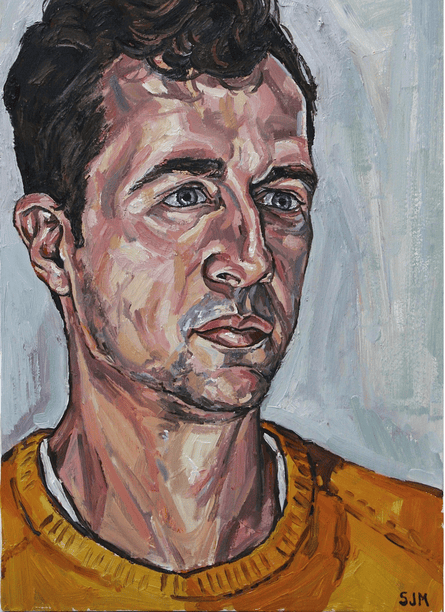
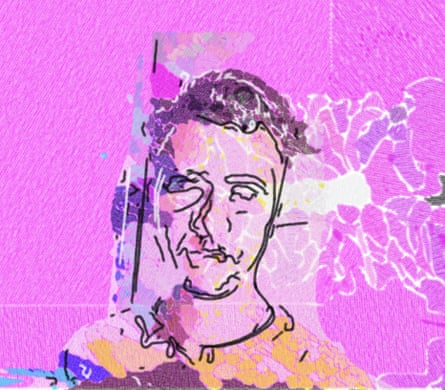
Then I think some more. For one thing, it turns out that art is more mechanical than I’d realised. “I try to look at Leo as an abstract set of shapes, forms, colours, tones,” Moon tells Colton, “to get away from the fact that that’s a nose. Because when you start to do that, you get caught up in what you think looks like a nose.”
“What the software does is break it down into colour regions,” Colton says.
“Yes, exactly,” Moon agrees. “I think that’s what the best painters do. It’s transcribing.” Afterwards she tells me she felt a kind of “kinship” with the software as they worked side by side.
More importantly, I realise that what matters isn’t how the machine paints; it’s how I see. Moon I understand, I think. She’s a person and I know how that feels, so I care about her picture. But what does it feel like to be the Painting Fool? Is that what its portraits are trying to tell me?
Verdict Moon’s painting is far richer; the Fool is still learning and has centuries of practice to go.
The translation test
Google Translate was the first piece of proper science fiction to come true, and it’s already a decade old. In many ways it typifies where AI has got to. Useful, sure; impressive, without question; but still clunky as hell, despite big improvements.
If you haven’t used it, it works like this: enter text or web links in any of 103 supported languages and you get a rough translation seconds later in any of the others. The app on your phone will transcribe what you say and then speak it back, translated (32 languages supported); it can replace the text of a foreign language sign or menu wherever you point the camera. No explanation is needed of how cool that is (and it’s free).
Globally, half a billion people use Google Translate each month, mostly those who don’t speak English (which is 80% of people) but who want to understand the internet (which is 50% English). “Most of our growth, and actually most of our traffic, comes from developing or emerging markets such as Brazil, Indonesia, India, Thailand,” says Barak Turovsky, head of product management and user experience at Google Translate. It’s surprisingly popular for dating, too, he adds. “Things like ‘I love you’ and ‘You have beautiful eyes’, that’s very prevalent.”
The software has always used a form of statistical machine learning: scouring the internet for already translated text – UN declarations, EU documents – and mapping the likelihood of certain words and phrases corresponding to one another. The more data it gathers, the better it gets, but the improvement levelled off a couple of years ago. Soon, Turovsky says, they will deploy new deep learning algorithms, which will produce much more fluent translations.
Even so, there are limits, and some seem fundamental when you talk to a human translator and realise how subtle their work is. Ros Schwartz and Anne de Freyman volunteer for this task. Both are professional French/English translators, and I need two because, in order to judge how good the translation is without being fluent in both languages, we need to translate twice – once out of English into French, once back again. Google Translate keeps no memory of the original and can do the same thing.
I choose a short passage of distinctive but not especially wild or ambiguous prose from the beginning of Herzog by Saul Bellow. Translators normally require context, so I tell Schwartz and De Freyman that it comes from a famous mid-century American novel.
Within a few days, Schwartz and De Freyman return a very smooth facsimile of the original text. Here and there some nuances have not survived, but the passage remains a pleasure to read, and the main meanings come across exactly.
Google Translate takes only a few seconds, and the result is both impressive and inadequate, weirdly good in places, in others weirdly bad – turning “he” into “it” and concocting the idea that Herzog is in love. Miraculously, it keeps “cracked” as a description of the hero. French has no word that combines the sense of “broken” and “mad” that cracked coveys in English, so De Freyman makes it “cinglé”, which comes back from Schwartz as “crazy”.
“Google Translate would look at statistical probability and say, what does ‘cracked’ mean?” Turovsky explains. “And statistically, it will try to decide whether it means ‘cracked’ or ‘crazy’ or whatever. That, for a machine, is a non-trivial task.” Nor is it simple for a human, even though we find it easy. You’d have to ask whether Bellow could have meant that Herzog was “cracked” as in physically fractured. Then you’d have to assume not, because human bodies don’t generally do that. So you’d wonder what he did mean and assume instead, if you were not already familiar with the usage, that he must mean “crazy”, because you understand the rest of what you’ve read. But to do all this, wouldn’t Google Translate have to be pretty much conscious, I ask? Turovsky laughs. “I don’t think I’m qualified to answer that question.”
Verdict Some bullseyes and howlers from Google Translate, while Schwartz and De Freyman are fluent and exact.
